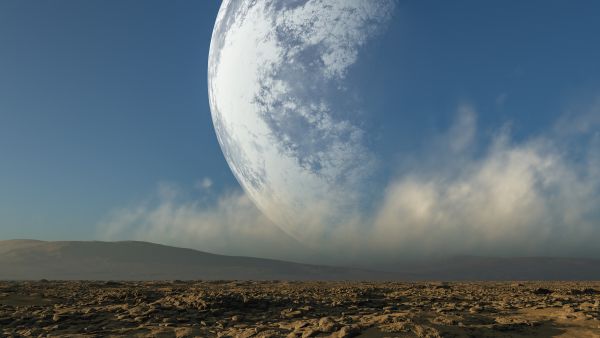What would happen if the moon were twice as close to Earth?
Spoiler alert: total chaos.

In the 2003 Jim Carrey movie "Bruce Almighty," Carrey's character suddenly acquires God-like powers, and uses those powers to lasso the full moon and pull it closer to Earth to woo his beloved. Later in the movie, background shots show TV news reports about massive, unprecedented flooding around the world.
While the film is obviously fantastical, it does raise a question: What would happen if the moon were twice as close to Earth than it is today?
In fact, the flooding scenario from the movie isn't far from what might actually happen if the moon were suddenly much closer to Earth, said Neil Comins, a physicist at the University of Maine. The best-known effect of the moon is its gravitational pull on Earth's oceans, which results in two high tides and two low tides every day.
But if the moon were half the distance from Earth as it is now, the tides would be eight times higher, Comins told Live Science. Some islands would be completely underwater for much of the day, and populated coastlines would likely become uninhabitable because of the high tides, he added.
Related: If you're on the moon, does Earth appear to go through phases?
But higher ocean tides wouldn't be the only result of a closer moon. The moon also has a tidal effect on Earth's land, Comins said.
If the moon were suddenly twice as close to Earth, the effect would be like hitting a gong with a mallet, Comins said: Waves of energy would reverberate through the planet due to the sudden increased strength of the moon's gravitational pull.
Get the Space.com Newsletter
Breaking space news, the latest updates on rocket launches, skywatching events and more!
And that sudden whack of gravity "would actually impact the Earth's crust, which means it might trigger more earthquakes, might trigger more volcanic eruptions," said Jazmin Scarlett, a historical and social volcanologist at the Queen Mary University of London.
Take, for example, Jupiter's moon Io, the most volcanically active world in the solar system, Scarlett said. Io's volcanism results from the push and pull from the gravity of Jupiter and two of its other moons. Earth might see a similar fate if the moon were suddenly half as close.
Along with all the sudden buckling of the planet's crust, Earth's spin would slow over time. This is because, as the moon's gravity pulls the oceans, the resulting friction between the ocean floor and water slows Earth's spin. Today, Earth's rotation is slowing by about one-thousandth of a second per century, Comins said. If the moon were half the distance away, Earth's rotation would slow even more, dragging out our days and nights.
If we were to survive the sudden earthquakes, volcanic eruptions, lengthening of days and nights, and higher tides, at least we'd get to see more frequent solar eclipses. Because the moon would cover a larger area of the sky, it would be more likely to pass in front of the sun from our perspective, Comins said. We'd even still be able to see the sun's corona (outer atmosphere) shining around the dark silhouette of the moon, but not as clearly, he added. Otherwise, the moon and its phases would look about the same, only bigger in the sky.
And what if the moon were to slowly spiral toward Earth, rather than just moving suddenly? The planet's crust and tides would shift more gradually, hopefully letting life adjust, Scarlett said. The longer days and nights could change our climate and drive evolutionary changes in multiple ways, Scarlett said. Animals would have to adapt to a brighter moon at night. For example, prey might have to learn how to hide better at night, as predators might have more light when hunting.
While a superpower-bestowing Morgan Freeman won't be the cause of an Earth-moon shake-up, could anything natural cause the moon to drift closer to Earth?
This is wild speculation of course, but Comins decided on an answer: "If a sufficiently massive object passed close to the Earth-moon system, and the moon was in the right place of its orbit as this thing went by, this thing could potentially take energy from the moon, and that would cause it to spiral in closer to us," Comins said.
So it would take a massive asteroid whizzing by Earth at the exact right place at the exact right time to possibly push the moon toward us like a ball circling a drain. Of course, even if that did happen, it would still take many, many years for the moon to get half the distance away as it is now, so Earth wouldn't feel the effects right away.
Originally published on Live Science.
Join our Space Forums to keep talking space on the latest missions, night sky and more! And if you have a news tip, correction or comment, let us know at: community@space.com.

JoAnna Wendel is a freelance science writer living in Portland, Oregon. She mainly covers Earth and planetary science but also loves the ocean, invertebrates, lichen and moss. JoAnna's work has appeared in Eos, Smithsonian Magazine, Knowable Magazine, Popular Science and more. JoAnna is also a science cartoonist and has published comics with Gizmodo, NASA, Science News for Students and more. She graduated from the University of Oregon with a degree in general sciences because she couldn't decide on her favorite area of science. In her spare time, JoAnna likes to hike, read, paint, do crossword puzzles and hang out with her cat, Pancake.










